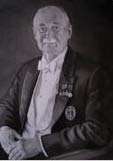Francis Moncrieff Kerr-Jarrett
Sir Francis Moncrieff Kerr-Jarrett (27 August 1885 – 13 December 1968) was a sugar manufacturer and landowner in Jamaica. He served as Custos Rotulorum of Saint James Parish, Jamaica (1933–65)[1] and was also chairman of the Jamaica Sugar Manufacturers' Association from 1930 to 1945.[2][3] He was a member of the Legislative Council of Jamaica from 1919 to 1921.[2][3] Kerr-Jarrett remains the longest serving Custos of Saint James Parish, Jamaica and was integral to the development of Montego Bay as a tourist resort.[4]
Sir Francis Moncrieff Kerr-Jarrett | |
|---|---|
 | |
| Born | 27 August 1885 |
| Died | 13 December 1968 (aged 83) |
| Education | Bedford Modern School |
Early life
Kerr-Jarrett was the son of the Hon. Herbert Jarrett Kerr, Custos of Trelawny Parish Jamaica, and Henrietta Theresa Vidal.[1] His grandfather had also been a Custos in Jamaica.[2] The Kerr-Jarrett family owned most of the land on which Montego Bay now stands including the 3,000 acre Barnett Estate and 18th century Great House.[5][6]
The young Kerr-Jarrett was educated as a boarder at Bedford Modern School.[1] During World War I he served as a Lieutenant with the Royal Army Service Corps.[7]
Career
Kerr-Jarrett became manager and owner of the Barnett Sugar Estates from 1910[8] and, after service in World War I, he was a member of the Legislative Council of Jamaica between 1919 and 1921.[9] He served as Chairman of the Jamaica Sugar Manufacturers’ Association between 1930 and 1945[9] and was Custos for St James, Jamaica between 1933 and 1965.[9] He was Chairman of Rose Hall Ltd in 1960.[9]
Kerr-Jarrett was a JP for the parish of St James, Jamaica[10] and was knighted in 1965 for public services to Jamaica.[9][11]
Personal life
Kerr-Jarret was interested in reading and public affairs.[9] He was Life President of the Montego Bay Cricket Club, a member of the Caledonian Club in London and The Liguanea Club in Jamaica.[9]
In 1909, Kerr-Jarrett married Adela Isabel Clerk; they had two sons, four daughters and lived at Catherine Hall in Montego Bay, Jamaica.[9] Kerr-Jarrett died in Jamaica on 13 December 1968.[9]
References
- "Who Was Who", Published by A&C Black Limited; online edition, Oxford University Press, 2014
- Smith, Lloyd Sydney (1955). "The British Caribbean Who, What, why". google.co.uk. Retrieved 6 July 2015.
- "Who's Who, Jamaica, British West Indies". google.co.uk. 1963. Retrieved 6 July 2015.
- "Bellefield Great House & Gardens - History". bellefieldgreathouse.com. Retrieved 6 July 2015.
- Cameron, Sarah (27 September 2013). Jamaica Footprint Focus Guide. google.co.uk. ISBN 9781909268333. Retrieved 6 July 2015.
- "Sugar". google.co.uk. 1920. Retrieved 6 July 2015.
- "Lieutenant Francis Moncrieff KERR-JARRETT Royal Army Service Corps". nationalarchives.gov.uk. Retrieved 6 July 2015.
- Jensen, Peta Gay (29 July 2005). The Last Colonials. google.co.uk. ISBN 9781845110338. Retrieved 6 July 2015.
- "Who's Who". ukwhoswho.com. Retrieved 6 July 2015.
- Cundall, Frank (1964). "The Handbook of Jamaica for ..." google.co.uk. Retrieved 6 July 2015.
- "Daily Mail Year Book". google.co.uk. 1966. Retrieved 6 July 2015.